PART TWO OF A TWO PART SERIES ON MY TRAVELS TO THE CHERNOBYL REGION, JULY 2019. READ THE FIRST PART, The Darker Side of Travel – Chernobyl.

It’s about 5 o’clock in the afternoon and the ten of us are a bit weary from a long day becoming temporary experts on types of radiation, a stainless steel sarcophagus, the word sarcophagus and creepy arrangements with radioactive dolls.
An email sent out ahead of time informed us that we would not be allowed to enter any of the buildings within the Chernobyl exclusion zone and here we are, in front of a former apartment, as vacant and lonely as Pluto. Our guide Olga suggests that each of us take a different route to the roof by entering one of four different areas of the building.
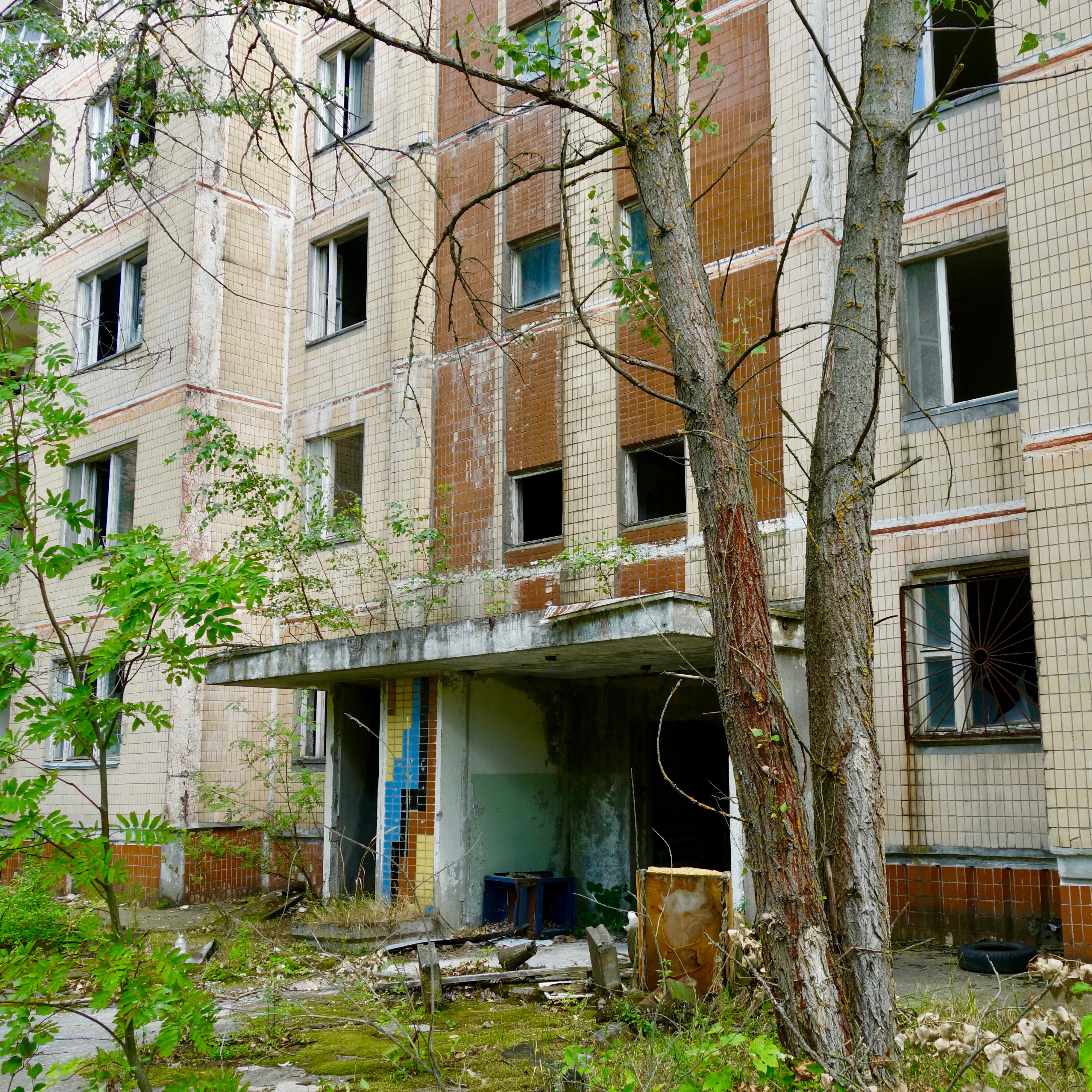
The others are a bit hesitant, still trying to understand our orders, or opportunity really, to experience a very impactful aspect of the day.
If I were a character in a slasher film, it’s very clear now that I’d be the first one to wander off alone to investigate that thumping sound in the wood shed out back… and of course the fate that comes with such a role.
I turn left and focus on the farthest entrance and dodge a few trees that seem begging for attention. Without really thinking, I step through the dark, low ceiling entrance to the building and focus on the debris leading to the stairwell going up. I go up a flight of stairs and come to what appears to be the mail box wall.
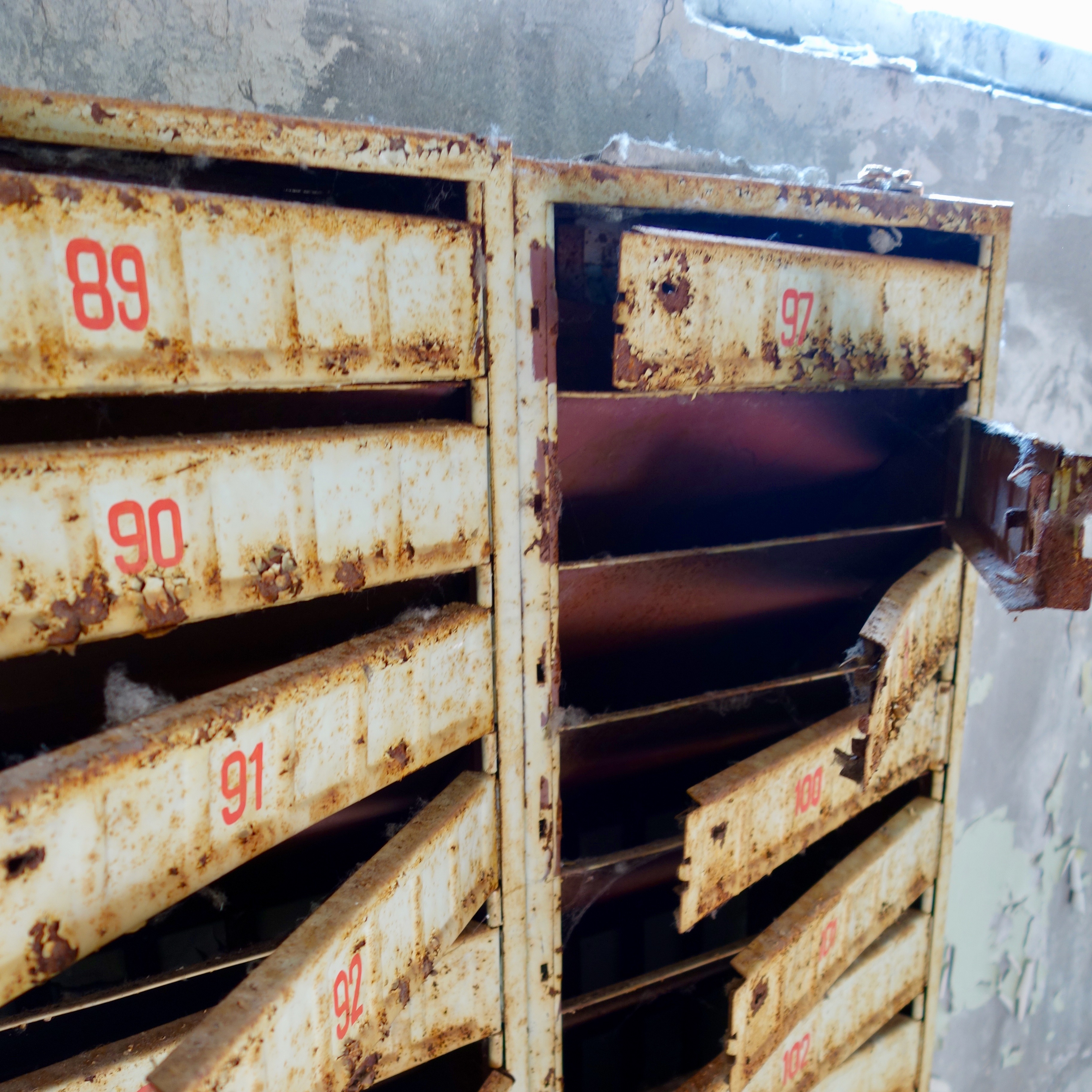
I keep going, wandering through the former apartments of celebrated workers of the specifically planned nuclear reactor complex. The prestigious community of Prypyat was developed to offer the best services to showcase the pinnacle of the good soviet life.
My mind seems to dismiss the fact that everything in the area, especially metal, is radioactive and I disappear into the shadows of the building to forge ahead, alone, to the roof.
If you’re wondering why I went to the Chernobyl Exclusion Zone, read the first part of this blog, The darker side of travel – Chernobyl, which might help you understand my interest with places representing the darker side of the human experience.
My day trip to the Chernobyl exclusion zone was a fantastic, educational enlightenment.
The day is full of interesting nooks and crannies and information, and for more specifics on the tour check out my additional post, Kessiworld review of Chernobyl experience.
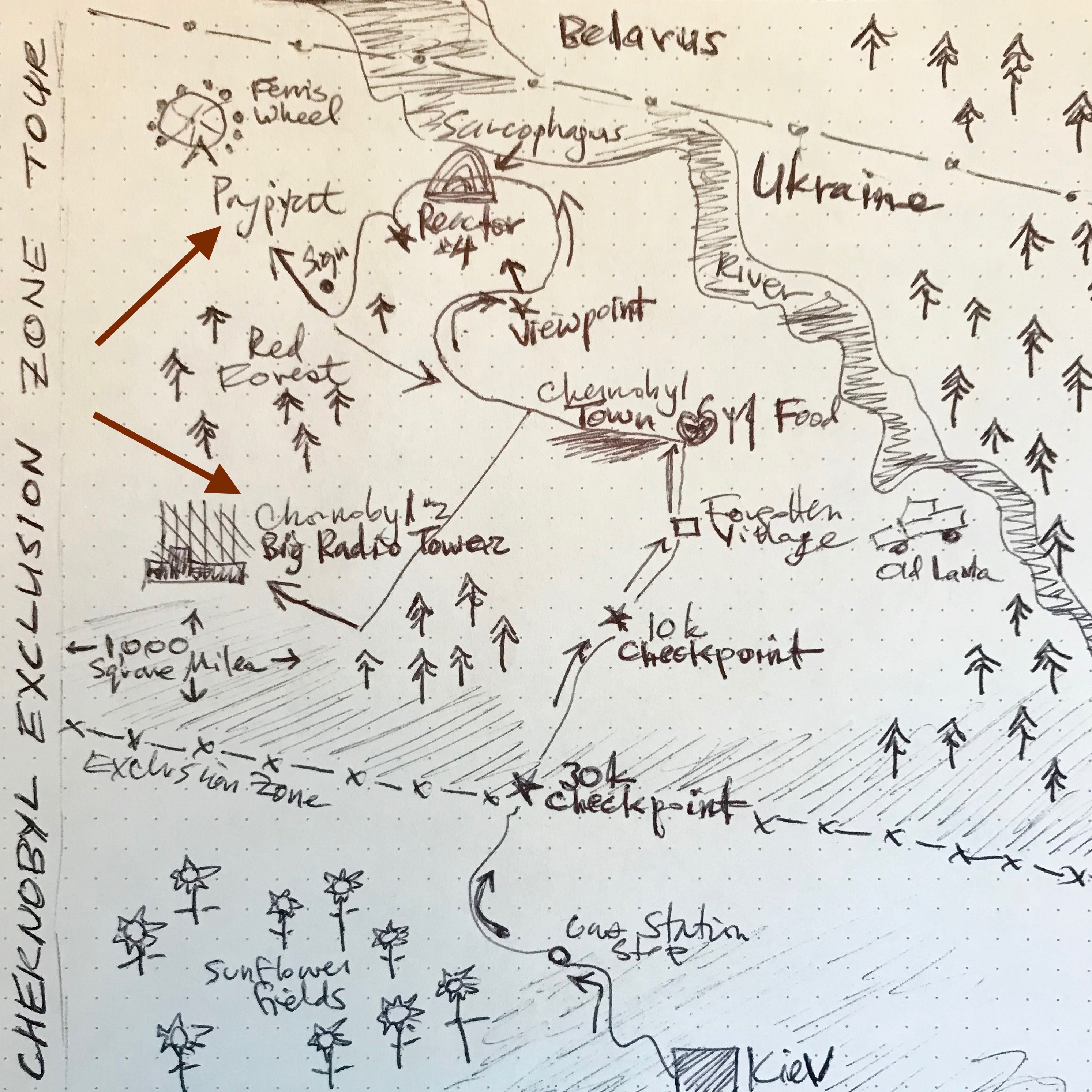
For now I’ll focus on two key areas of the experience; the secret soviet military installation Chernobyl 2 and the planned community of Prypyat.

Part I: Chernobyl 2 – the secret soviet military installation

Imagine it, Cold War realness in the thick of the 1970’s. The soviets and US are racing to show their dominance in the world. The USSR designates a rural area of north central Ukraine to a new development of nuclear reactors, up to 8, to be built along the Prypyat River. A beautiful planned community also takes form a few miles away for the workers and their families.
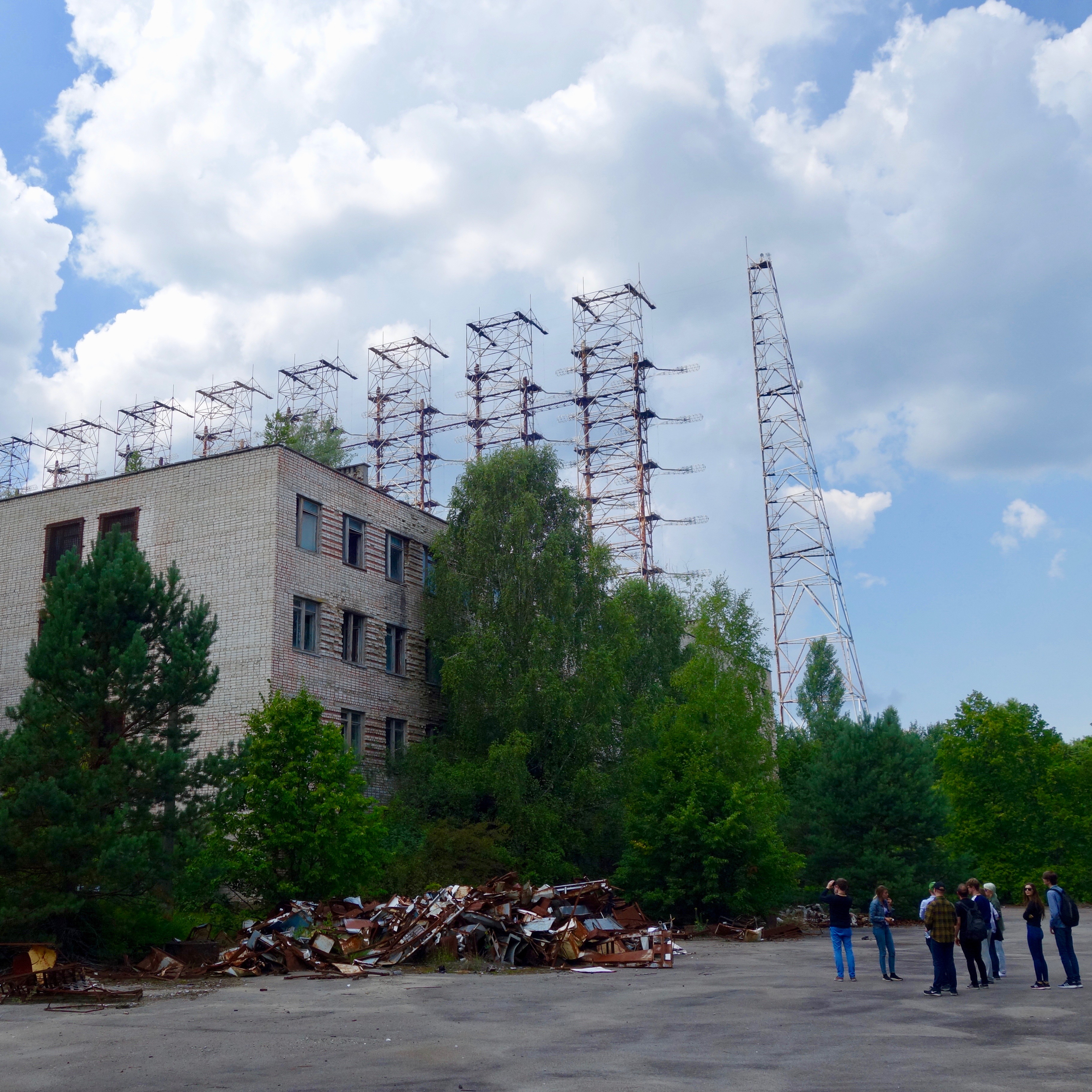
Amongst all this development and acreage is a perfect location to also create a top secret military base. Close to transportation links associated with the power plants and access to abundant energy produced by the nuclear reactors. Ukraine’s location in Europe is ideal for intelligence on the world of the West.
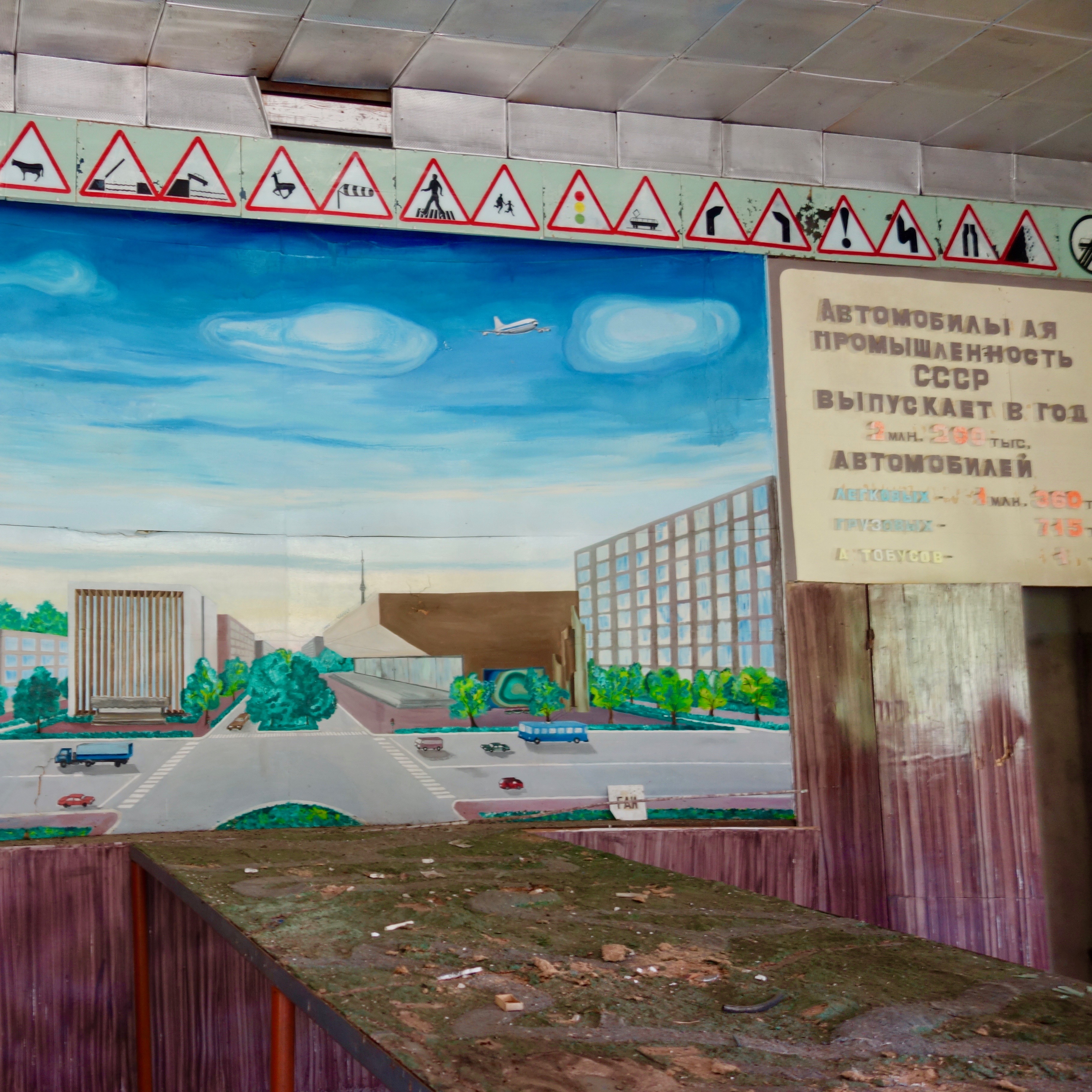
The name is Chernobyl 2 to avoid suspicion and any wanderers in the surrounding forests are told it’s a children’s summer camp.
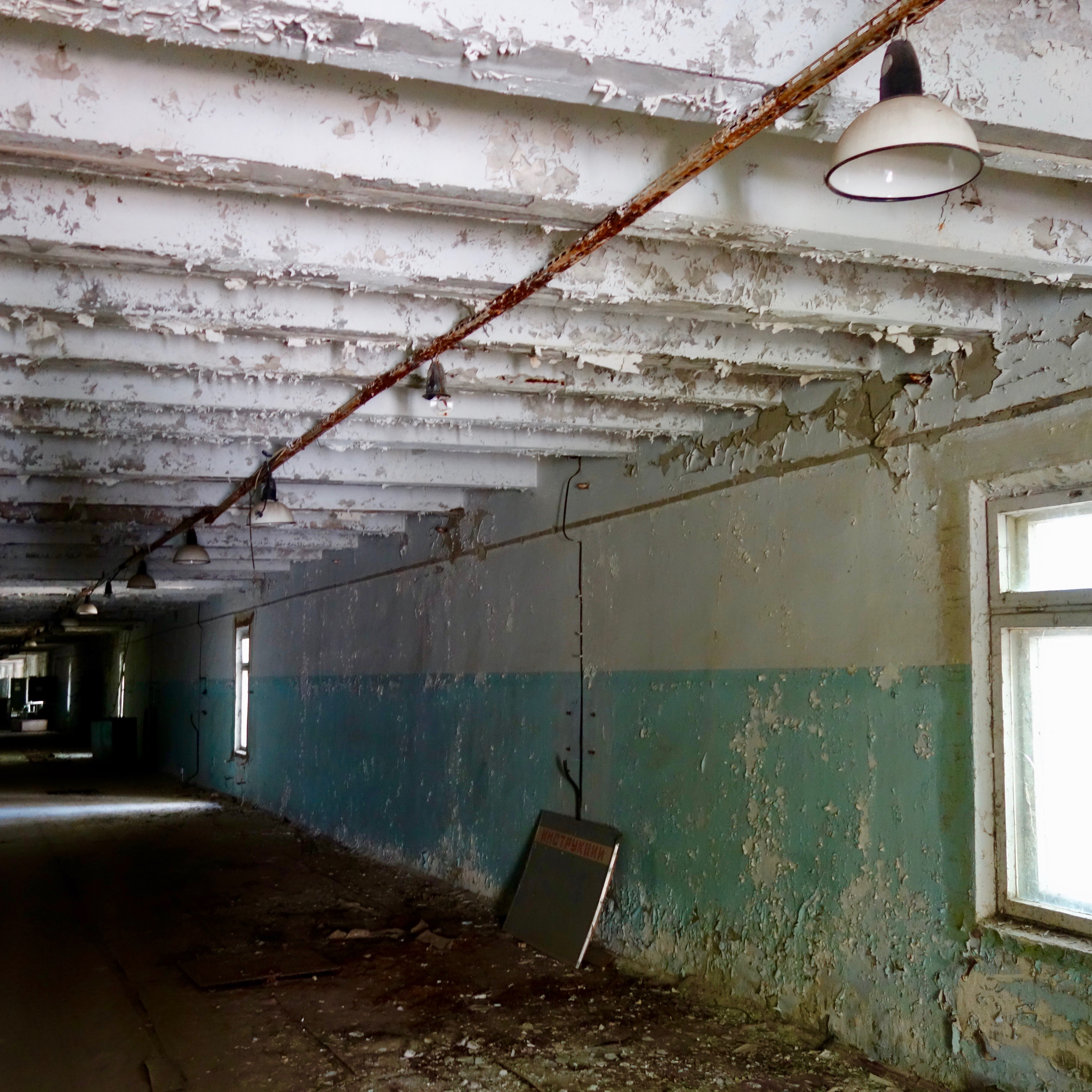
An early warning detection system was erected here in the 1970’s to detect NATO and US ballistic missiles. The system was very powerful and the apparatus huge; over 600 feet wide and 200 feet tall. The strong rat-tat-tat sounds of the waves going out and coming back annoyed radio dispatchers across the globe and the system became known as the Russian Woodpecker. More information on the Russian Woodpecker.
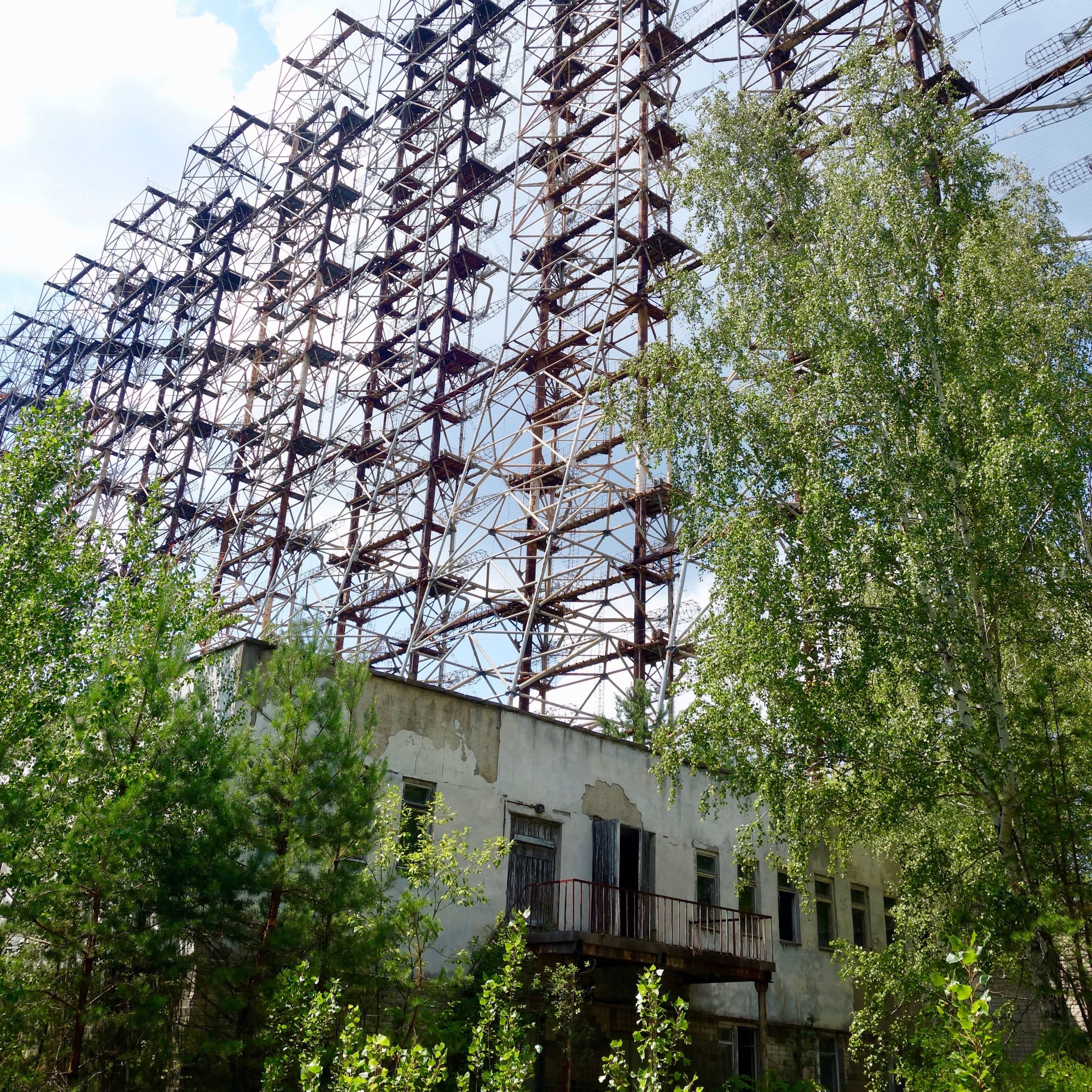
Before the Chernobyl disaster, the Russian Woodpecker operated with about 250MB of data and all this was housed in huge buildings near the radar. The system used 1/4 of the power produced by the 4 active reactors, or one entire reactor.

After the Chernobyl disaster the base was evacuated and since there was a power shortage the radar was decommissioned. To dismantle would spew more radiation into the air and the contaminated metal has no place to go besides buried underground. So today it’s left to remain a monument to failed soviet technology.
Part II: About Prypyat
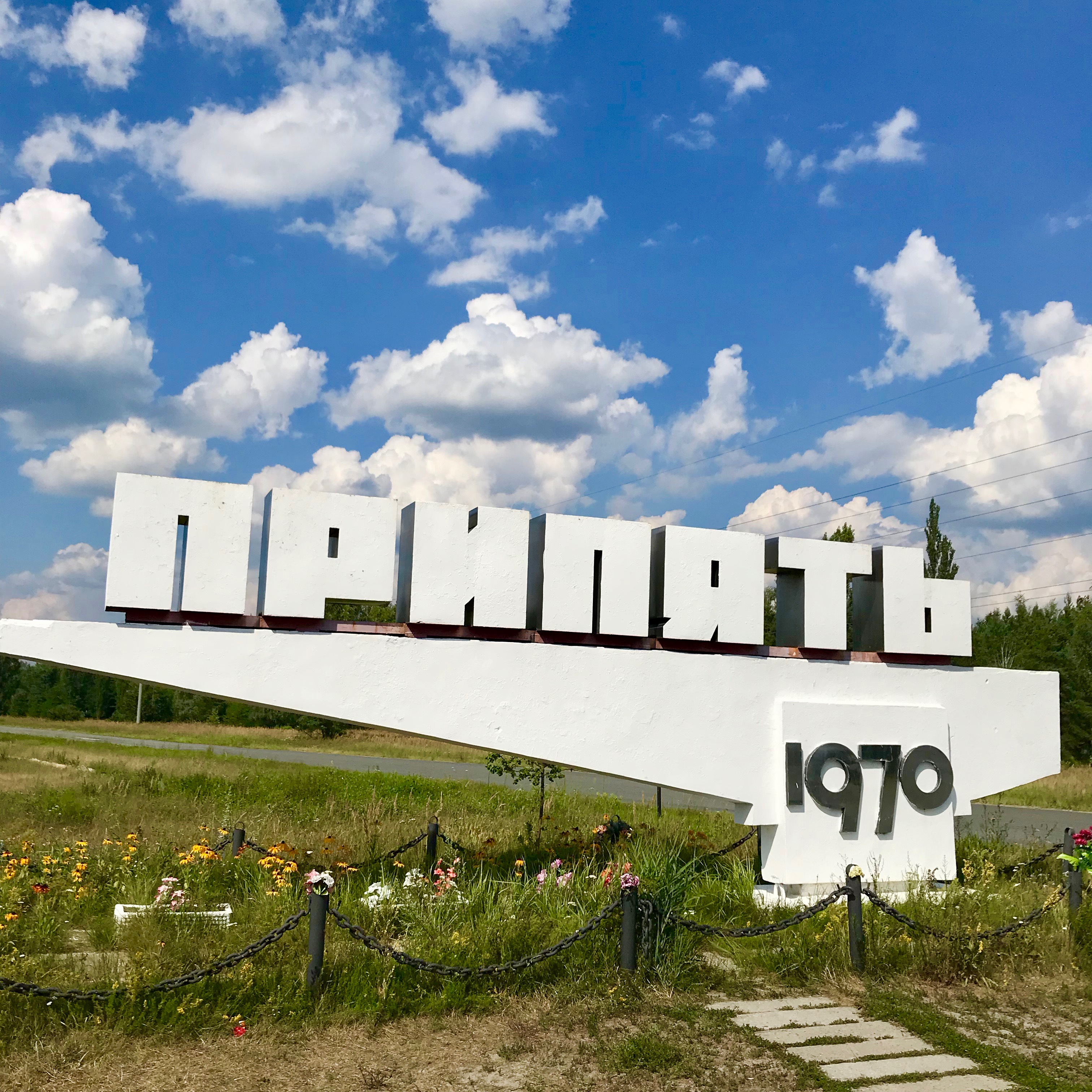
Since the reactors were built, by design, in the middle of nowhere, and would employ thousands, work began to create an exceptional community conveniently within a few miles of the power plants that would provide the workers and their families with all the modern conveniences of a city. Amenities like a movie theater, VIP hotel, shopping center, full sized track area and world class aquatic center were built to give the feeling of urban sophistication. Prypyat was to the be shining star of soviet achievement and reward for the best and brightest minds in the eastern sphere of influence.
Life in Prypyat changed drastically in the early morning hours of April 26, 1986 when a series of mistakes around a test of the emergency systems led to an “impossible” massive steam explosion blowing the cover off reactor #4, exposing the areas around the reactor to high levels of radiation.
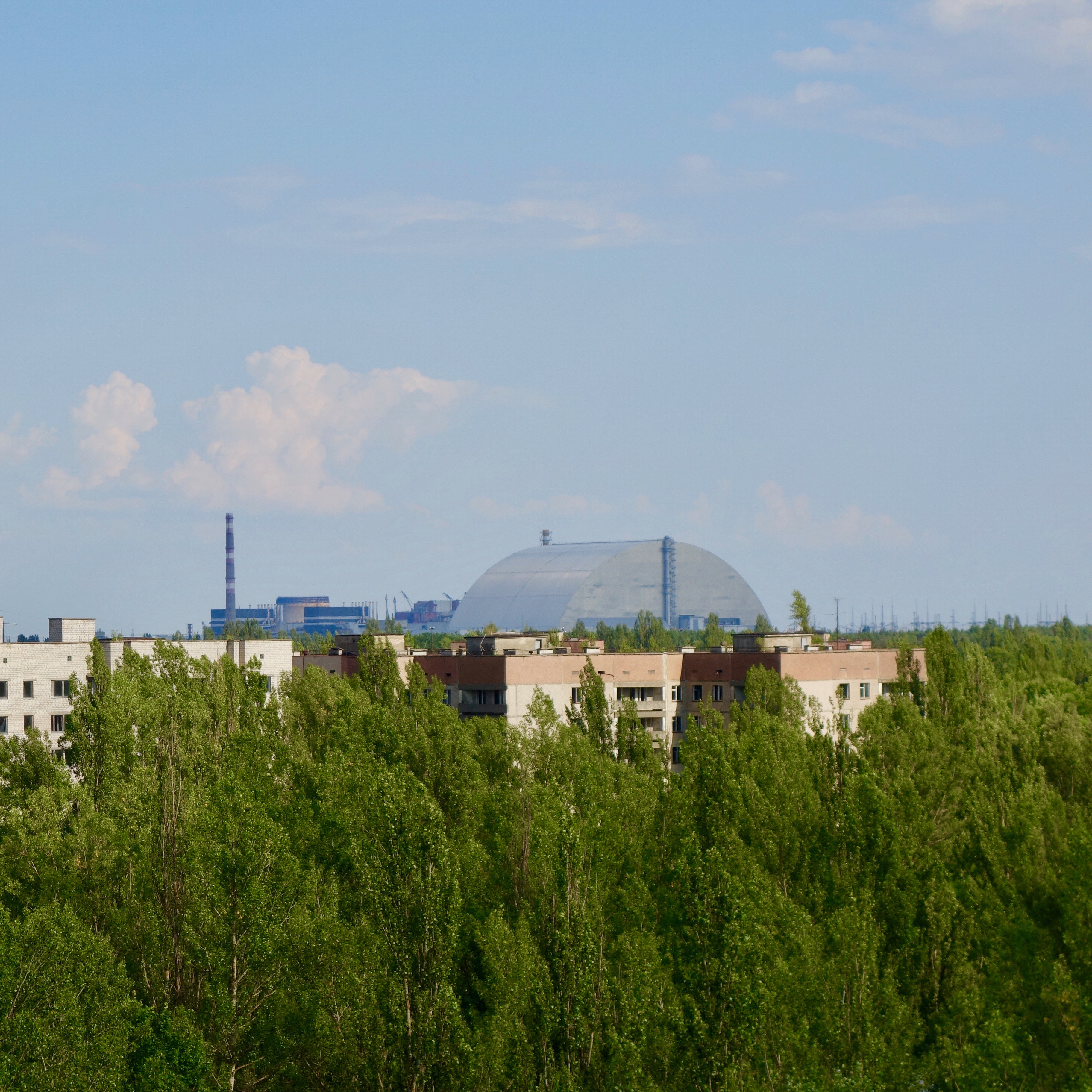
Initial communication lines about the accident were crossed all over, and the soviet leadership worked to mange the narrative rather than focus on the people. The citizens of Prypyat continued living in their community, only a few miles away from deathly radioactive material. During the day after the blast, kids played outside, weddings took place and life moved on even as people started noticing a metallic taste in the air.
Later, in the early morning of April 27, busses arrived and everyone was required to leave with only what they could carry out of their homes. Some people even brought animals on the bus with them.
Although “liquidators” worked to try to neutralize the contamination and over the years the buildings were looted, Prypyat is mostly a time capsule. A monument to the soviet dream that was working feverishly to stay alive in the dawn of the information era of the 1980’s.
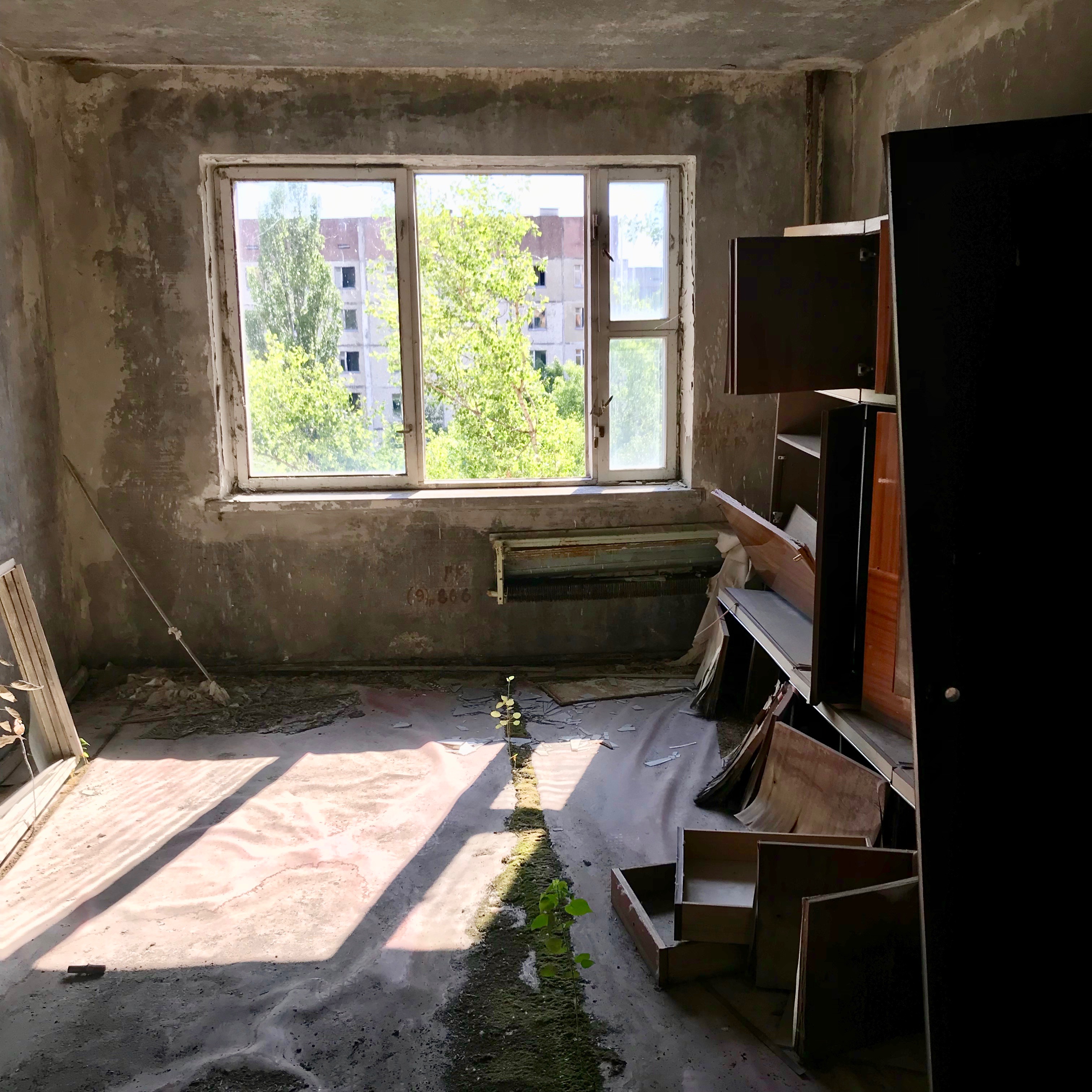
Part III: Submerged in a ghost city
Much of our day was spent on the mini-bus, at checkpoints, viewing roadside signs and measuring radiation with our Geiger counters in various spots from trees to bushes to creepy dolls to a mound of sand above the red forest. There was a nice non-radioactive meal and an up close view of the sarcophagus covering reactor #4.
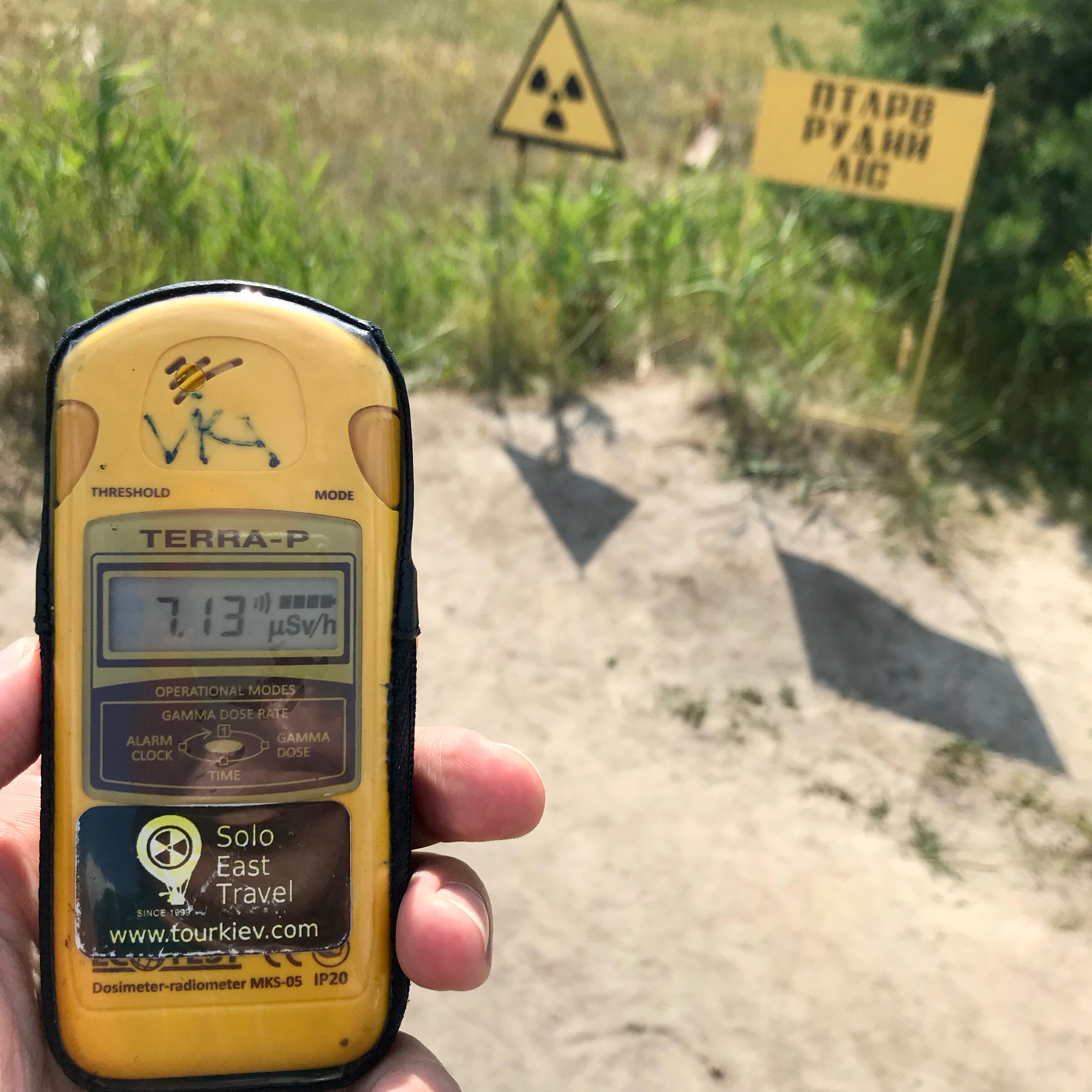
We stopped at the Prypyat sign for a photo op and to load up on more radiation, since we were right above what used to be the red forest (the trees were cut down and buried in this area). The Geiger counter went crazy beeping and then it was time to jump back in the van.
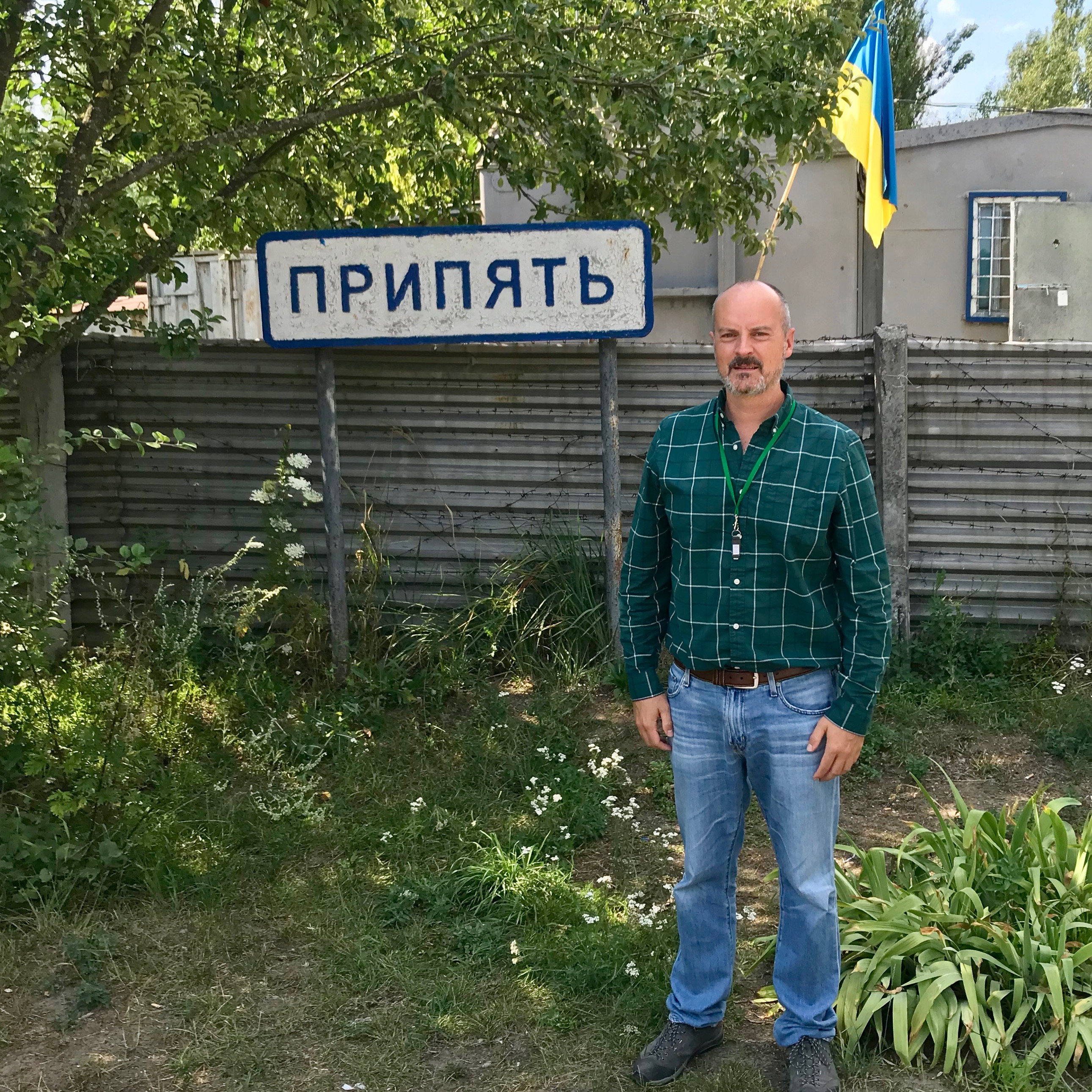
The final checkpoint to Prypyat involves an unmotivated uniformed guard wandering out to the street to pull the cord to lift the “gate” which is a narrow round piece of wood with faded stripes of red and white.
We were in, driving down Lenin Avenue. The guide noted that while all the other Lenin Avenues in Ukraine were changed to different names following the collapse of the USSR, this one remains to pay homage to 1986.

The bus dropped us off right in front of the main shopping complex and we were on foot for the next hour or so. The ghost city is woven together by the many poplar trees, originally planted to frame in the stately Lenin Avenue and the vastness of the main shopping square. These trees and their offspring have grown to fill in the landscape everywhere, with a dense jungle-like feel.

Olga moved around the sequence of our tour so we would not have other groups smothering us, so it felt like the last operating mini bus in the world was dropping us off in the middle of a zombie apocalypse zone. The sun was bright, even in the afternoon hours and she outlined some of the prominent buildings within our sights, including the apartment building for the VIP’s, the local hotel for visiting dignitaries and the movie theatre.
There was the shopping center, complete with an eerily vacant grocery store. Some of the walls now have more modern murals painted on the sides. Whereas I enjoy this type of art in places like Berlin or old warehouses in Minsk, this felt more invasive, almost as if someone was attempting to revise history by painting a smiling girl on a red bouncy ball.
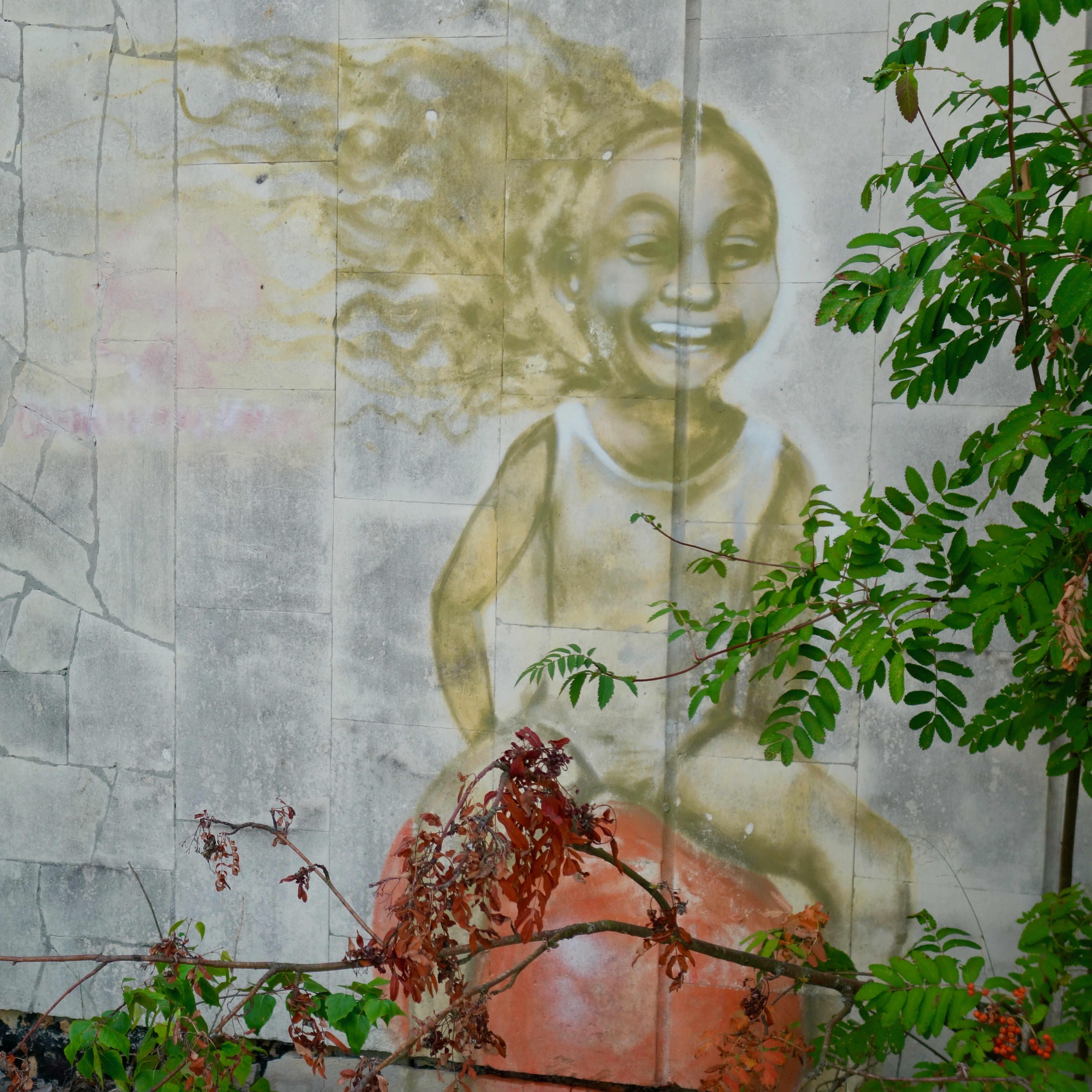
Still no sight of zombies, so we pushed further through other buildings with various artifacts of the soviet era of propaganda and the remnants of cyrillic signs hanging by threads.

It’s difficult to get a spacial understanding of the area because there is so much thick vegetation powerfully working to reclaim the development with a cocoon-like frenzy. Trees and other vegetation are everywhere, and we pushed through another thicket to an opening of old pavement and the rising view of the yellow pods attached to the now iconic ferris wheel of a traveling carnival set up in preparation for the May 1, 1986 celebration of Worker’s Day.
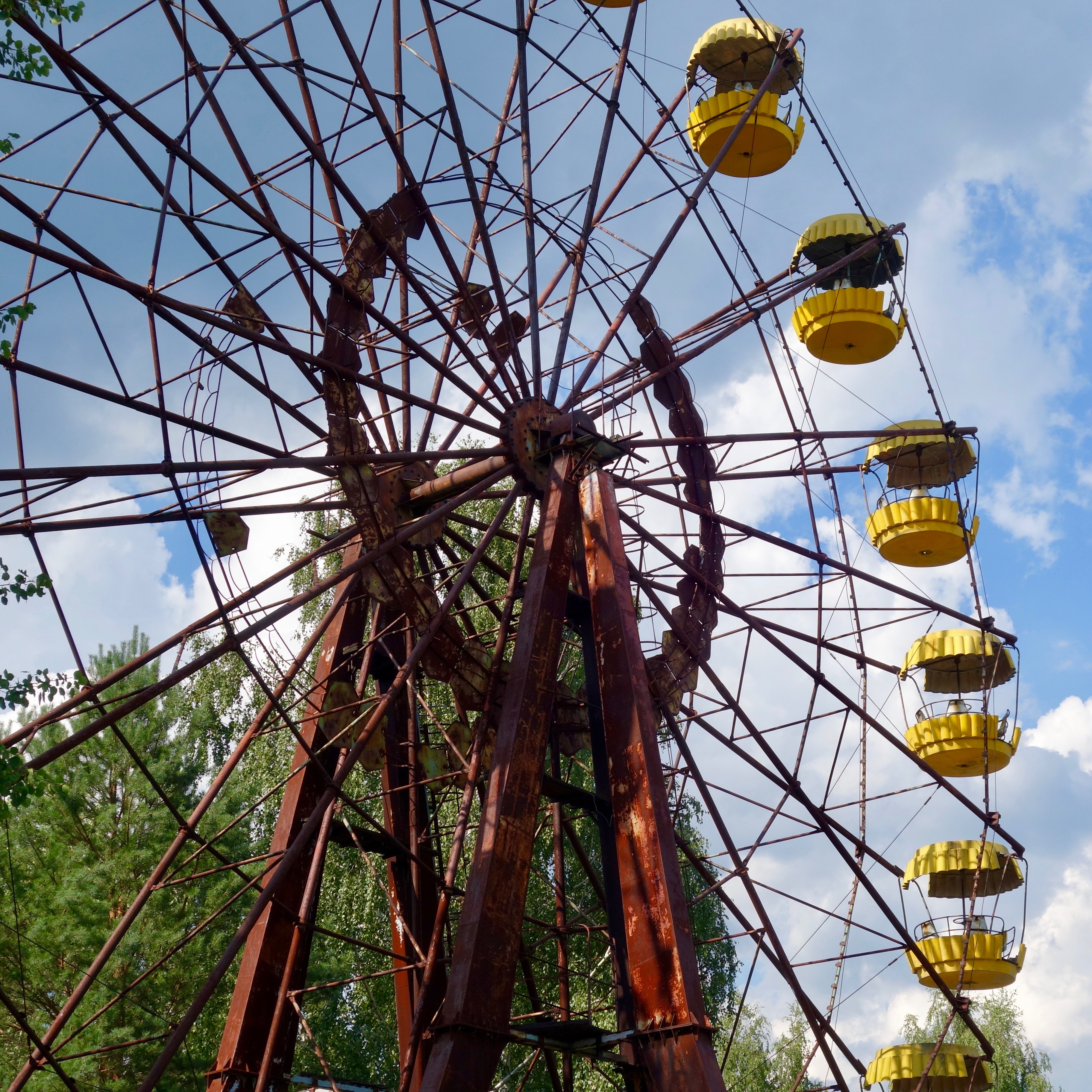
There was time to wander around and snap photos with firm directives not to touch the metal or try to sit in the seat of the ferris wheel pods. No licking either. Eventually our guide had us gather around the lowest yellow pod to read the Geiger counter, which was going crazy at about 17.0. For reference, downtown Kiev was .18, an airplane ride across the Atlantic provides about 3.0 and the area above the red forest was about 7.5.
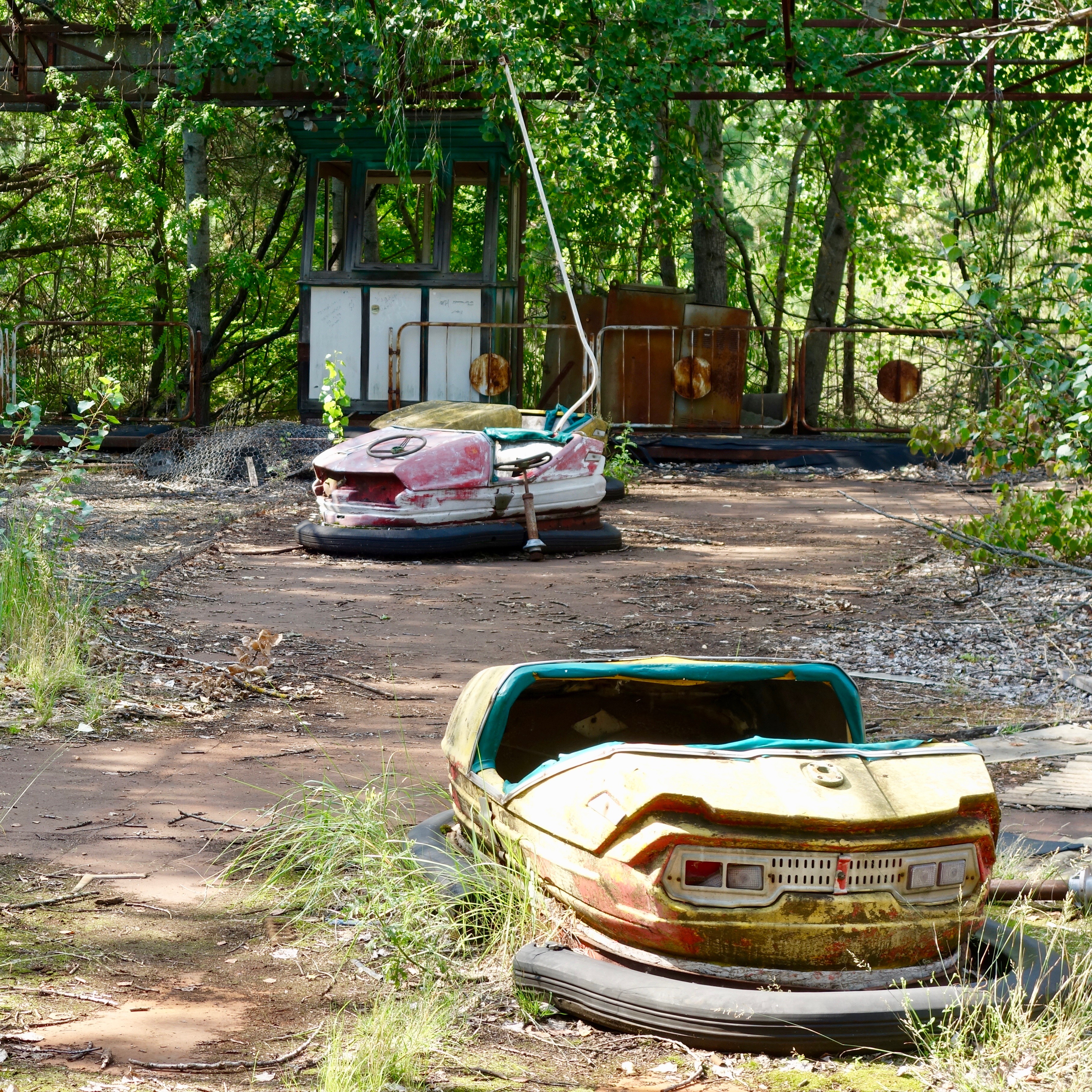
A question came up about dismantling the Ferris wheel and Olga’s answer was cryptic but something along the lines that the metal wheel is stable in the current state and now an icon for the area. Just don’t come into contact with any surfaces and no one gets hurt.
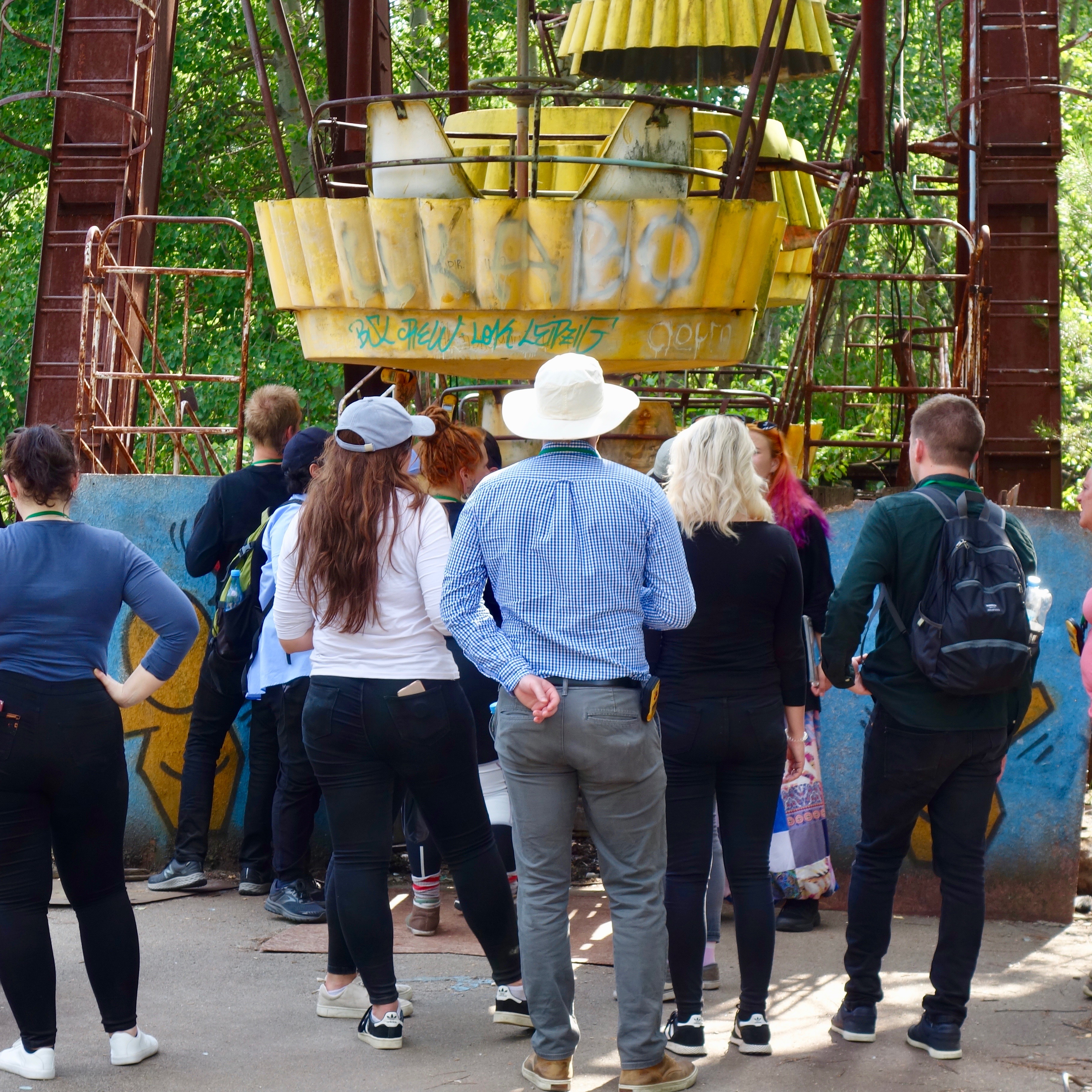
Eventually another group did approach the carnival area, and I wondered if we’d have them at our heels for the rest of the visit. But Olga had a few more tricks up her sleeve. We veered off left at the former track stadium and pushed through even more vegetation to arrive at the entrance of an apartment building.
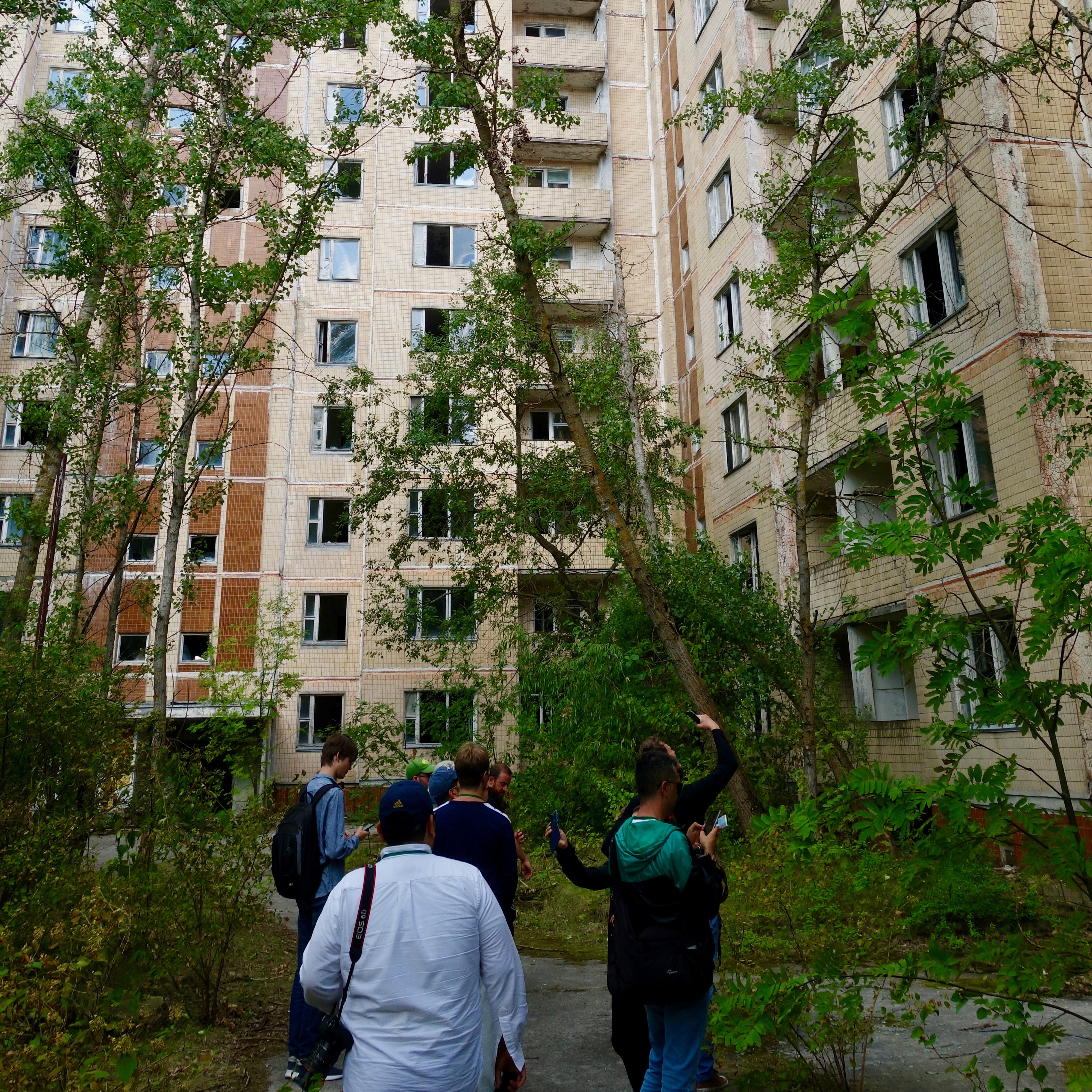
She asked us if we wanted to go to to the roof and who would say no to that?
I’ve described this feeling of entering this shrine to the people of Prypyat at the beginning of this post.
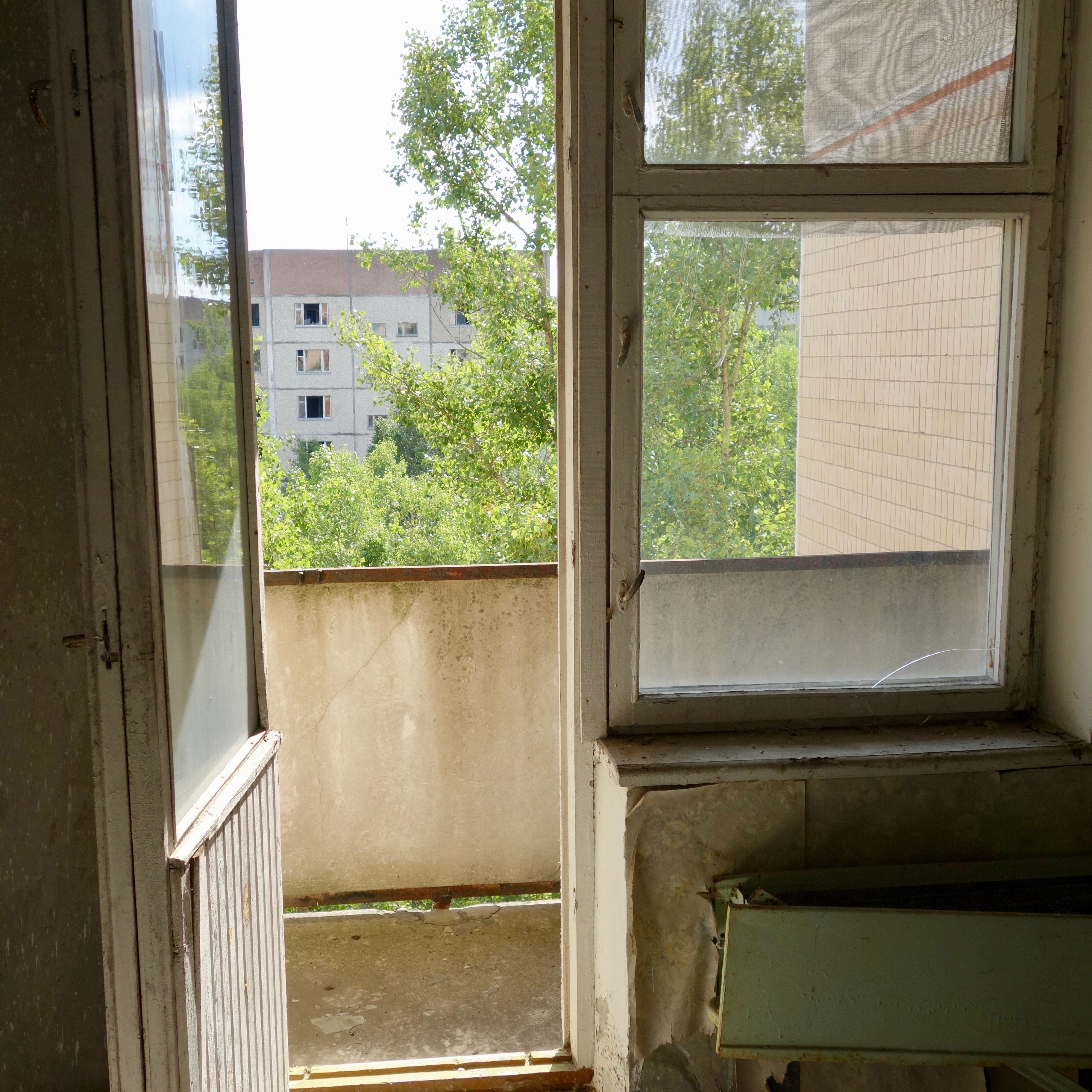
Whereas the energy around the shopping center and carnival were more aligned with zombies, this experience was ghostly. These were the actual apartments where people housed their hopes and dreams for living in a beautiful, prestigious area. Perhaps a reward for time spent in school learning very specific trades around nuclear science. Maybe a chance to move away from the harshness of Siberia to get a bit closer to the west?
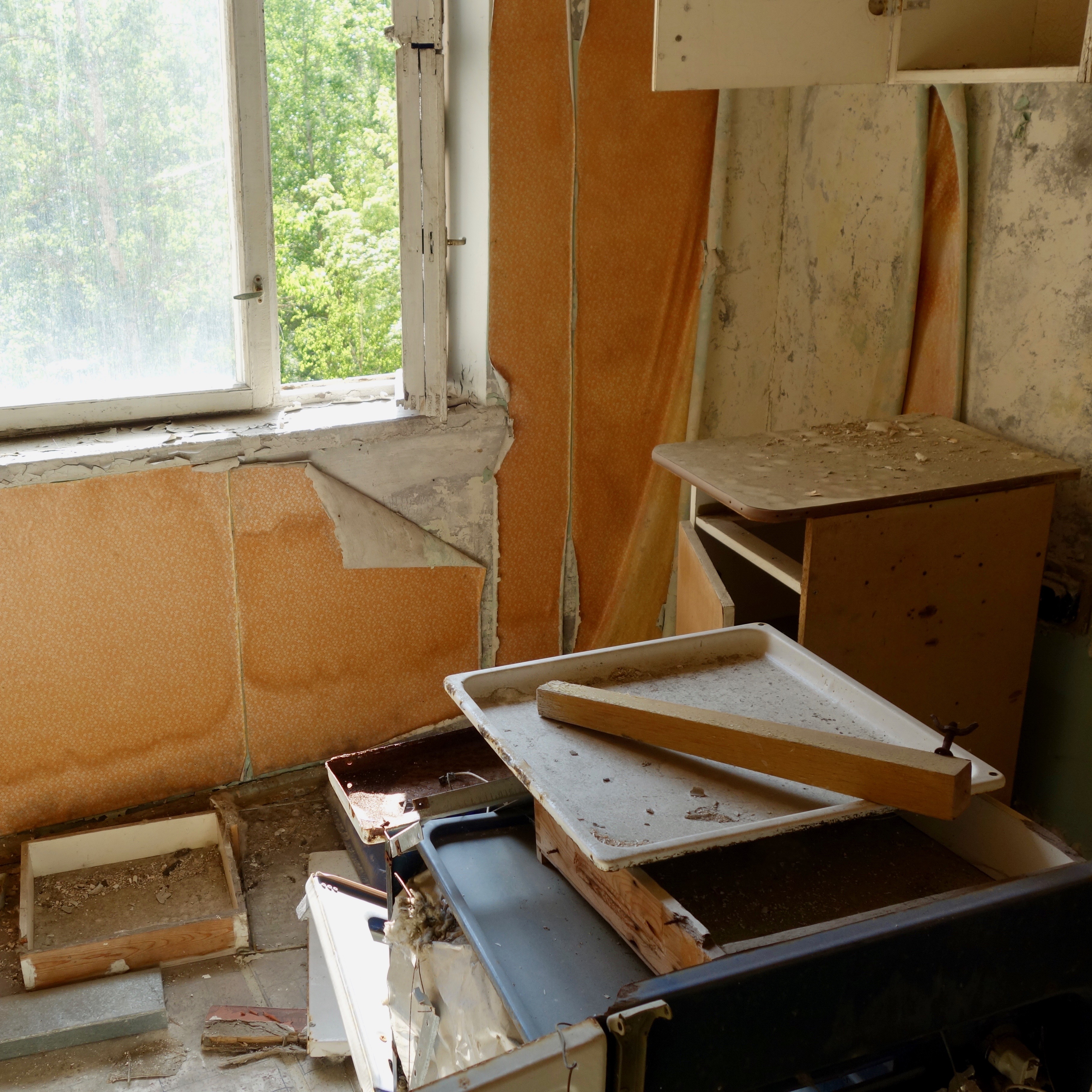
Although supposedly cleaned of radiation and then looted, the building seemed to hold the history within the crumbling walls. I explored a few apartments on each floor until reaching the entrance to the roof, which is featured in the video at the top of this blog.
These houses were within a few miles of Reactor #4 and I can’t imagine the power of the blast and ensuing radiation and debris.
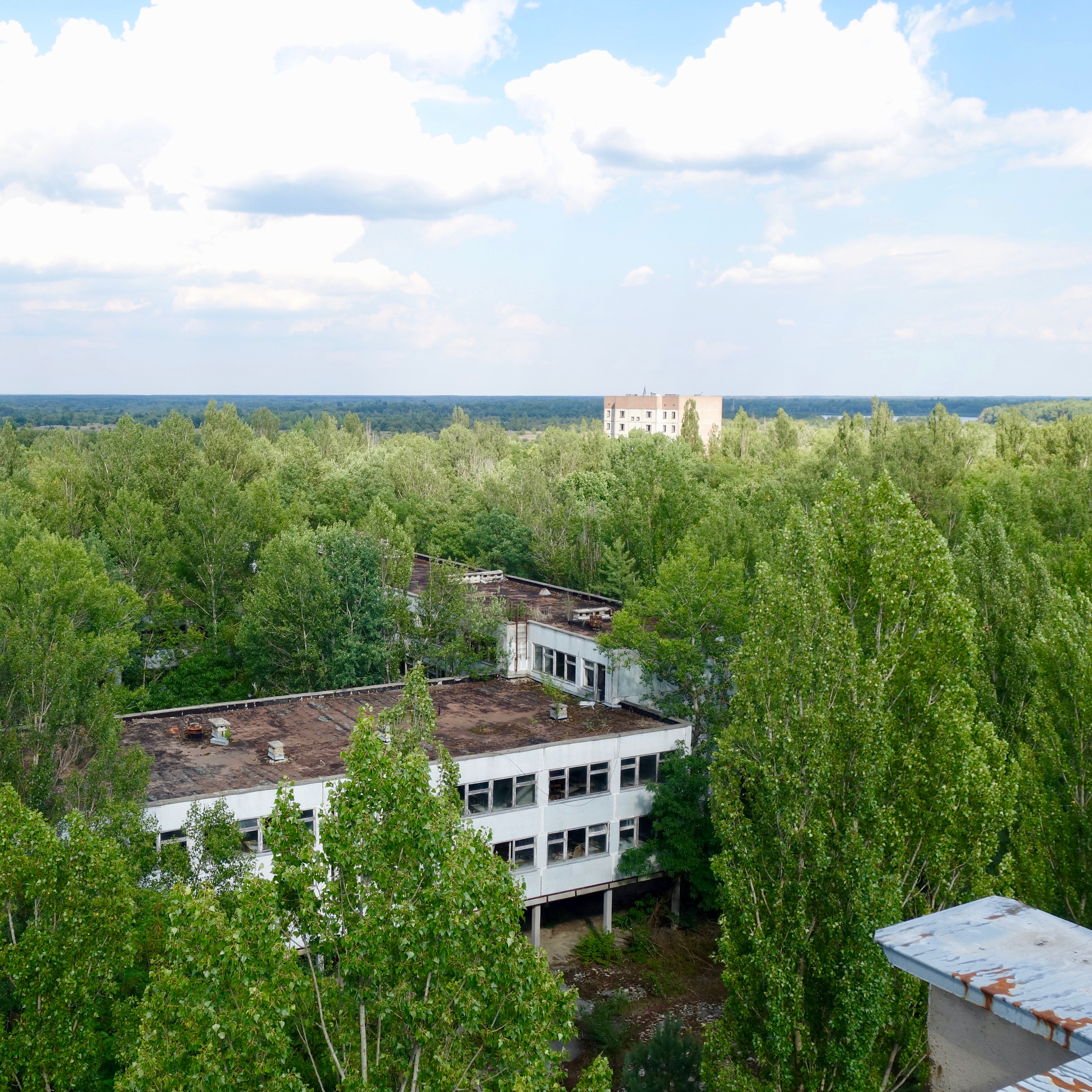
The view from the top of the building gave me a much better understanding of the area, the living environment, the space that Prypyat allowed. Although filled in completely with trees, this planned community seemed special compared to most soviet era developments I’ve seen in Moscow, Kiev and other places.
Since our group took on the divide and conquer method, I seemed to be the only one in this part of the building, which added to the creepy nature of the experience. But even with others around, Prypyat has a very unique energy that serves up ghosts of the past mixed with a live force that seems to be working hard to push forward. This is evident in the trees pushing through any surface with enough fatigue to allow.
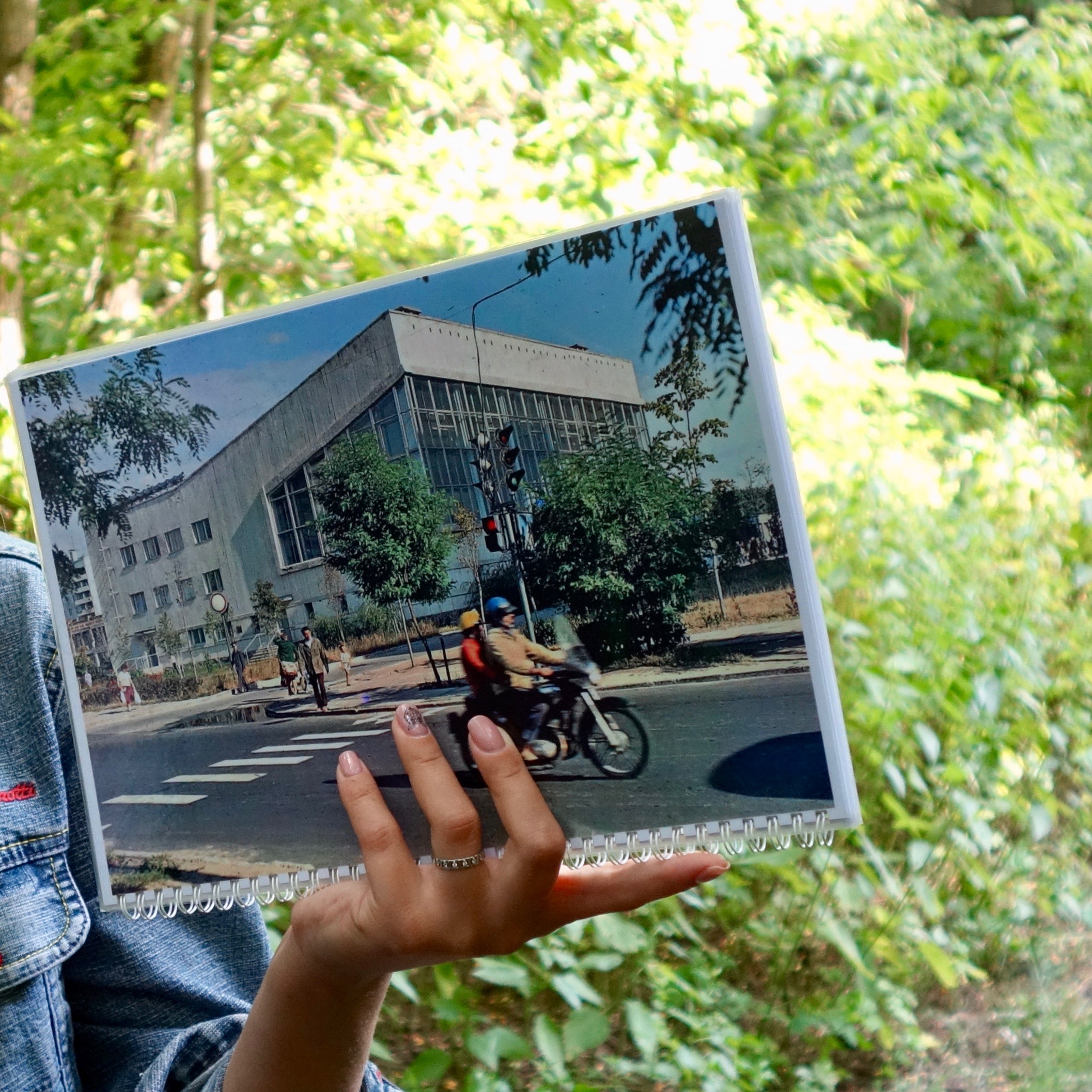
Just when I thought our time in this ghost town was complete, Olga pulled out one last trick. We jumped in the van and drove down what is now a narrow road, but used to be a main, proud thoroughfare to the the state-of-the-art aquatic center.
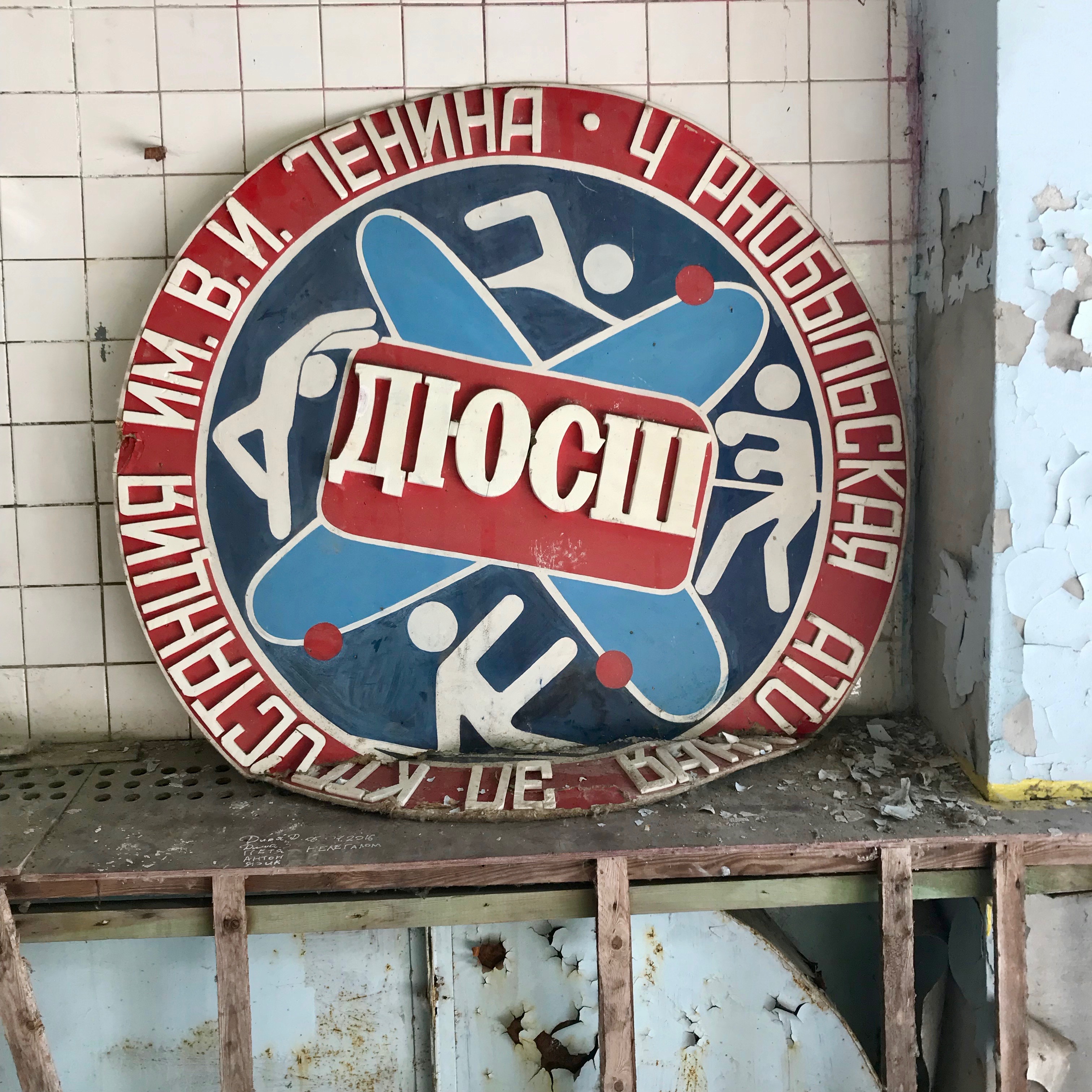
At about 5:30pm, although the sun was still shining, there were so many trees covering the entrance area that shadows began to form. I can only imagine what this would be like in the winter hours of dusk. We entered the building through side steps that took us into what would’ve been a grand lobby entrance to the center. Up some stairs to an indoor basketball court, with oak floors still in good shape.
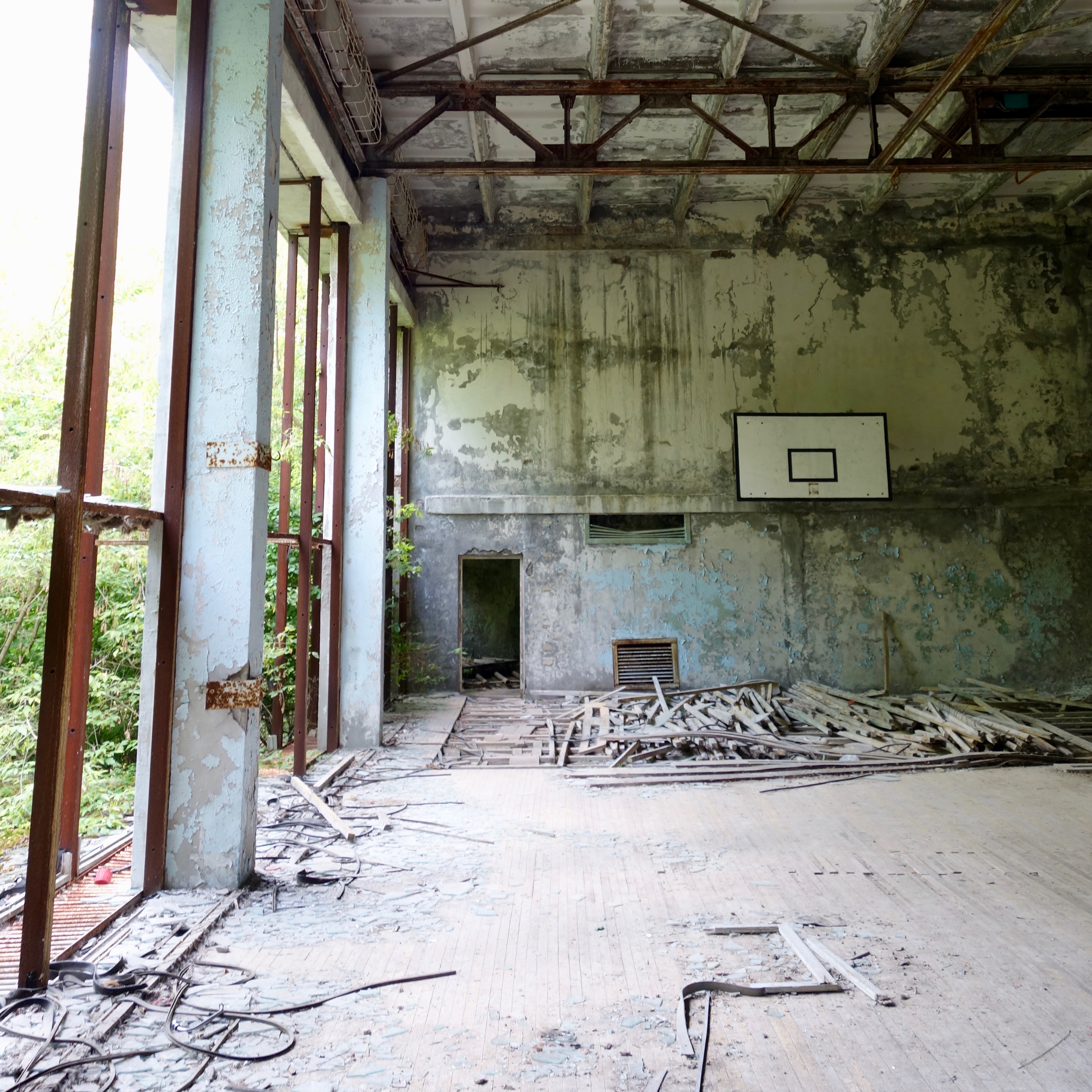
We pushed through a few more dark corridors that maybe served as locker rooms out to the wow of a dormant aquatic center. An empty Olympic sized swimming pool with two levels of diving boards.

Although with my group, I felt transported back into time of 1986 and it didn’t matter that living people were around me, snapping pictures and pointing out cyrillic signs. The vastness of the room allowed for my own private experience.
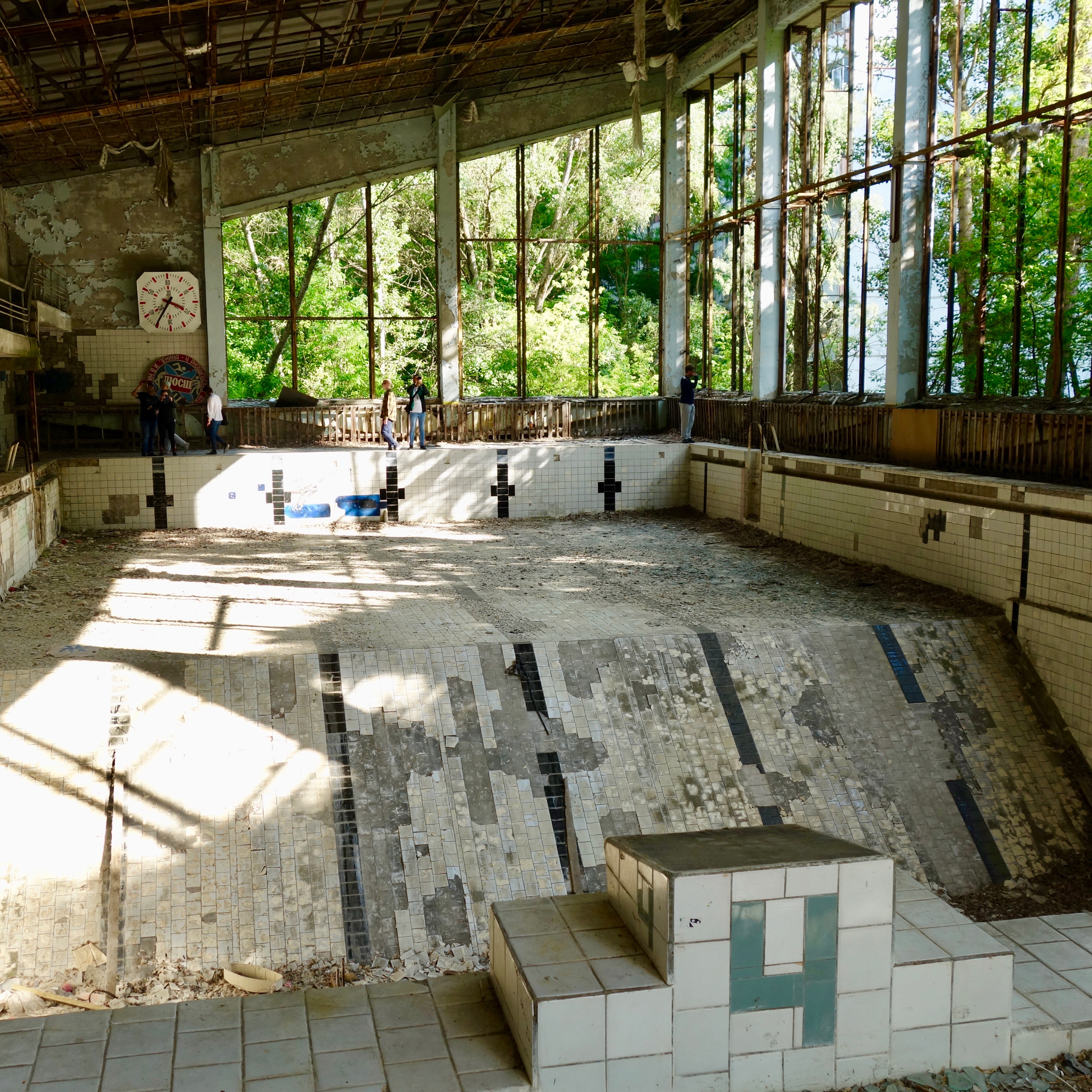
Prypyat represents hopes and dreams that were never realized. Trust in the soviet system that let the people down first by forcing a reckless test of the reactor system that would cause a massive global crisis and then working tirelessly to veil the incident with state talking points and lies.
Yet, there is a fight to live that pushes up and out like the poplar trees. The ferrel dogs that hang out in this area are descendants of pets left behind and not euthanized back in 1986. They stand as proof that life can hang on and fight. The 1000 square mile exclusion zone is one giant monument to human failings and also human spirit.
And a nod to nature forging on to cover up the wounds with lush green foliage.
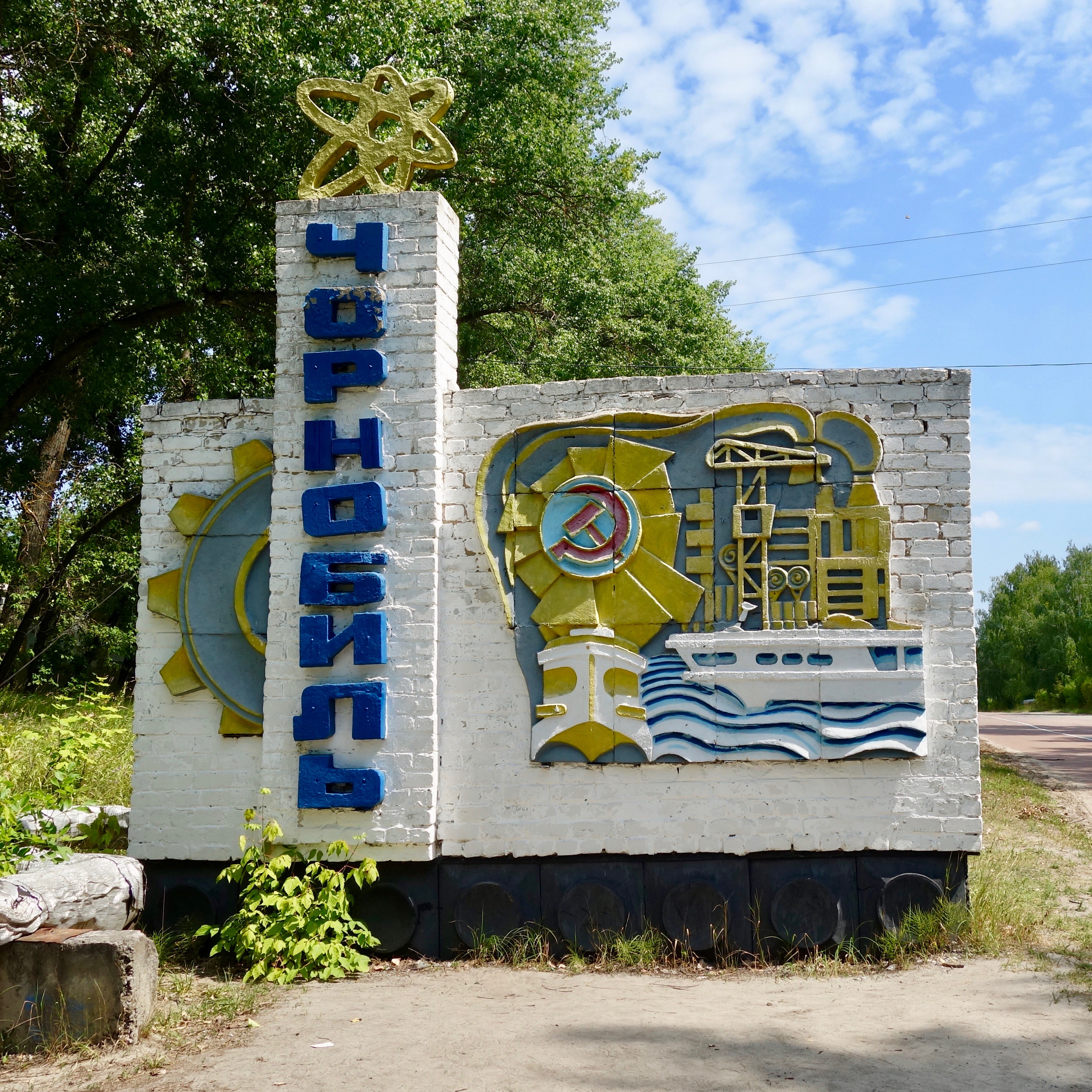
The return drive to Kiev took a few hours and as we passed the fields of bright blooming sunflowers I reflected on the day. It’s amazing that all these artifacts are generally completely open to the touring public. No glass walls or signs saying “do not touch.”
The relics of 1986 on display for us to see, feel, experience.
I’m very thankful I had this opportunity to witness the many aspects of the exclusion zone and hope this one-of-a-kind theme park inspires future visitors to honor those lost and strive to avoid calamities like this in the future.

